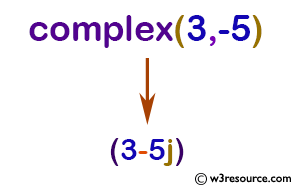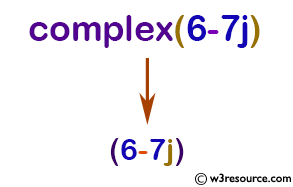Python: complex() function
complex() function
The complex() function is used to create a complex number or convert a string or number to a complex number.
The complex type is described in Numeric Types — int, float, complex.
Syntax:
complex([real[, imag]])
Version:
(Python 3)
If the first parameter is a string, it will be interpreted as a complex number and the function must be called without a second parameter.
The second parameter can never be a string. Each argument may be any numeric type (including complex).
If imag is omitted, it defaults to zero and the function serves as a numeric conversion function like int() and float(). If both arguments are omitted, returns 0j.
Return value:
Return a complex number with the value real + imag*1j or convert a string or number to a complex number.
Note: When converting from a string, the string must not contain whitespace around the central + or - operator. For example, complex('1+2j') is fine, but complex('1 + 2j') raises ValueError.
Example: Create a complex number in Python
x = complex(3, -5)
print(x)
x = complex(1)
print(x)
x = complex()
print(x)
x = complex('6-7j')
print(x)
Output:
(3-5j) (1+0j) 0j (6-7j)
Pictorial Presentation:

Pictorial Presentation:

Example: Create complex Number Without Using complex()
x = 3+5j
print('x =',x)
print('Type of x is',type(x))
y = -5j
print('y =',y)
print('Type of y is',type(x))
z = 0j
print('z =',z)
print('Type of z is',type(z))
Output:
x = (3+5j) Type of x isy = (-0-5j) Type of y is z = 0j Type of z is
Python Code Editor:
Previous: compile()
Next: delattr()
Test your Python skills with w3resource's quiz
